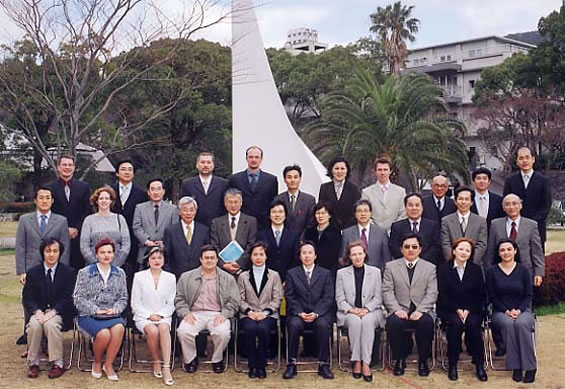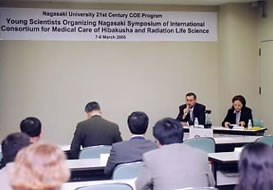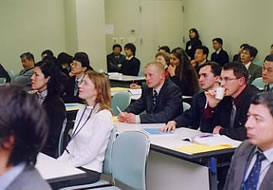| |
| Young Scientists Organizing
Nagasaki Symposium |

The International Symposium entitled “Young Scientists Organizing
Nagasaki Symposium” was held on March 7-8, 2005 at the Pompe
van Meerdervooft Hall in the Nagasaki University School of Medicine,
as part of the projects of 21st Century COE Program “International
Consortium for Medical Care of Hibakusha and Radiation Life Science”.
The number of participants amounted to 95, including 16 (10 abroad
and 6 domestic) invited speakers. The up-and-coming young scientists,
in the fields of Medical Care of Hibakusha, Radiation Epidemiology,
Regenerative Medicine, Radiation Biology, and Molecular Cellbiology,
presented their latest data and discussed on them.
The Symposium organized by young scientists, such as assistant
professors and graduate students of the committee members, was
a great success. It contributed to one of the projects of the COE
Program: educating young scientists as leaders of Radiation Life
Sciences in the next generation.
It will be expected to continue in the future to hold these symposiums
and workshops for the program in order to promote research with
top-level scientists in the world and to provide young scientists
with opportunities to expose them to international scientific communications.
 |
 |
| Program |
Venue: Pompe van Meerdervoort Hall
Nagasaki University School of Medicine |
Day 1 (7 March)
| Opening |
|
| 09:30-09:40 |
Welcome address to Young Scientists Organizing Nagasaki Symposium
Masao Tomonaga, COE Program Leader, Nagasaki University |
| |
| Session 1 |
International Medical Cooperation and Epidemiology
| Chair: |
Vladimir Saenko, Nagasaki University
Tamara Zhunussova, Nagasaki University |
|
| 9:40-10:05 |
Medical cooperative projects: from Nagasaki to Chernobyl
and Semipalatinsk |
| 10:05-10:30 |
TCR-assay and micronucleated reticulocytes as biological
dosimeters in RIT (Radioiodine therapy) patients
| |
Stanislav Vershenya, University
of Wuerzburg, Germany |
|
| 10:30-10:55 |
A novel NF-κB inhibitor, DHMEQ, potentiates the radiosensitivity
of thyroid cancer cells
| |
Dmytro Starenki, Nagasaki University |
|
| 10:55-11:20 |
Different role of JNK and p38 kinases in ionizing radiation-induced
thyroid cell radio-sensitization
| |
Alexei Podtcheko,
Nagasaki University |
|
| 11:20-11:45 |
Long-term health effects among offspring of parents chronically
exposed on the Techa River, Southern Urals
| |
Evgenia Ostroumova,
Urals Research Center for Radiation Medicine, Russian
Federation |
|
| 11:45-12:10 |
Epidemiology of hematological diseases of adult population
living in a zone of Semipalatinsk nuclear test site, 1994-2003
| |
Ainur Akilzhanova,
Semipalatinsk State Medical Academy, Kazakhstan |
|
| |
| Group photo, Lunch |
| 12:10-13:40 |
|
| |
| Session 2 |
Radiation Emergency Medicine and Regenerative Medicine,
e-Learning
| Chair: |
Kazuhiro Nagai, Nagasaki University
Noboru Takamura, Nagasaki University |
|
| 13:40-14:05 |
Phenotypic and functional characterization of adult stem
cell populations
| |
Yumi Matsusaki, Keio
University School of Medicine, Japan |
|
| 14:05-14:30 |
Sensitive in vivo assay system for human stem cells
using NOD/SCID/γcnull mice
| |
Hidefumi Hiramatsu,
Kyoto University, Japan |
|
| 14:30-14:55 |
Current situation and future scope of radiation emergency
medical care network in Nagasaki
| |
Mariko Morishita,
Nagasaki University |
|
| 14:55-15:20 |
Telemedical technologies in education.experience of introduction
and prospect of development at medical university of Gomel
(Belarus)
| |
Natallia Fedartsova,
Gomel State Medical University, Belarus |
|
| |
| Coffee break |
| 15:20-15:50 |
|
| |
| Special lecture |
| |
| Chair: |
Masao Tomonaga, Nagasaki University |
|
| 15:50-16:50 |
Possibilities for collaboration between the 21st Century
COE Program at Nagasaki University and WHO/HQ
| |
Shunichi Yamashita,
WHO Headquarters, Geneva, Switzerland |
|
| |
| Reception |
| 18:00- |
|
Day 2 (8 March)
| Session 3 |
Radiation Biology
| Chair: |
Evagelia C. Laiakis, University
of Maryland, USA
Motohiro Yamauchi, Nagasaki University |
|
| 9:30-09:55 |
The role of phosphorylation on IR-induced p53 stabilization
and activation
| |
Motohiro Yamauchi, Nagasaki University |
|
| 9:55-10:20 |
Delayed Activation of IGF-1R/Src/MAPK/Egr-1 Signaling Regulates
Clusterin Expression, a Pro-Survival Factor
| |
Tracy Criswell, Vanderbilt University,
USA |
|
| 10:20-10:45 |
A new paradigm of oxidative stress in biological organisms
| |
Brad L. Upham, Michigan State
University, USA |
|
| 10:45-11:10 |
Evidence for induction of DNA double strand breaks in the
bystander response to targeted soft X-rays in CHO cells
| |
Genro Kashino, Nagasaki
University |
|
| 11:10-11:35 |
Contribution of bystander effects in radiation induced genotoxicity
| |
Hongning Zhou, Columbia
University Medical Center, USA |
|
| 11:35-12:00 |
A role for bystander-like factors in maintaining genomic
instability
| |
Evagelia C. Laiakis,
University of Maryland, USA |
|
| |
| Lunch |
| 12:00-13:30 |
|
| |
| Session 4 |
Atomic Bomb Survivors' Medical Care and Epidemiology
| Chair: |
Yasushi Miyazaki, Nagasaki University
Wan-Ling Hsu, Radiation Effects Research Foundation,
Japan |
|
| 13:30-13:55 |
Segmental jumping translocation of Ret oncogene in radiation-associated
thyroid cancer
| |
Masahiro Nakashima,
Nagasaki University |
|
| 13:55-14:20 |
Point mutations in the AML1/RUNX1 gene associated with myelodysplastic
syndrome
| |
Hironori Harada,
Hiroshima University, Japan |
|
| 14:20-14:45 |
Radiation, inflammatory biomarkers, and cancer mortality – a
study among RERF’s adult health study subjects
| |
Wan-Ling Hsu, Radiation
Effects Research Foundation, Japan |
|
| |
| Coffee break |
| 14:45-15:15 |
|
| |
| 15:15-15:40 |
Analysis of cancer mortality among atomic bomb survivors
in Hiroshima prefecture, 1968 –1997
| |
Tamara Zhunussova,
Nagasaki University |
|
| 15:40-16:05 |
Thyroid diseases in Hiroshima and Nagasaki atomic-bomb survivors
| |
Misa Imaizumi, Radiation
Effects Research Foundation, Japan |
|
| 16:05-16:30 |
Epidemiology of myelodysplastic syndromes among Nagasaki
atomic bomb survivors
| |
Masako Iwanaga, Nagasaki
University |
|
| |
| Closing remarks |
| |
Nakashima Masahiro, Management Committee, Nagasaki
University |
|